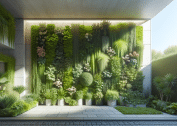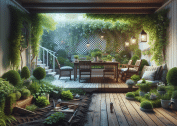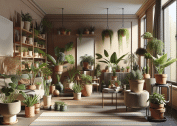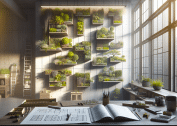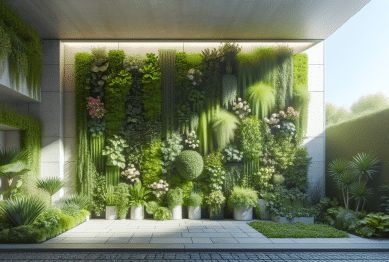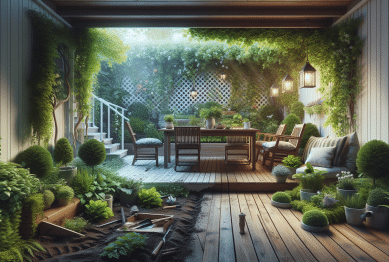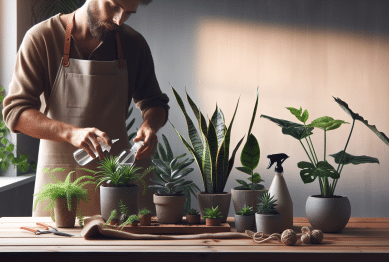Transforming your home exterior is easier than many assume. This guide explores trending curb appeal ideas, offering real-world inspiration and practical tips for landscaping, lighting, and outdoor upgrades. Discover how small exterior enhancements can boost property value and create lasting impressions. Curb appeal matters—and these tips highlight simple, beautiful ways to achieve it.
Why Curb Appeal Should Not Be Ignored
Curb appeal describes the visual impression made by a home’s exterior. Real estate experts report that curb appeal has measurable influence on buyer interest and neighborhood satisfaction (Source: https://www.huduser.gov/portal/periodicals/em/winter13/highlight3.html). When people drive or walk by, the lawn, garden, paint, and lighting collectively form a first impression. Even minor updates—like new planters, modern house numbers, or fresh mulch—help a property stand out. Improving these features doesn’t always require a large budget or major renovations. Thoughtful details truly count.
Many homeowners overlook curb appeal when focusing on interior projects. However, researchers from Virginia Tech have shown that properties with enhanced landscaping and neat, well-maintained façades experience up to seven percent greater home value increases than comparable homes without landscaping upgrades (Source: https://www.pubs.ext.vt.edu/426/426-722/426-722.html). The challenge is picking features that make a meaningful difference without exceeding a realistic budget. Prioritizing symmetry, healthy plants, and inviting walkways can help anyone get started. These steps provide a foundation for lasting visual appeal.
Residents often report greater well-being when they maintain their home’s appearance. A pretty exterior leads to more positive neighborhood perceptions, fewer disputes, and even increased property longevity. Regularly cleaning, repainting, or planting new flowers can have quick, noticeable effects. Choosing native plants also reduces upkeep and supports local ecosystems. Over time, updates build community pride and personal satisfaction.
Landscaping Tips That Boost Home Value
Effective curb appeal landscaping begins with a well-planned design. University horticulturists advise homeowners to focus on plant diversity—mixing shapes, sizes, and colors for visual interest. Adding evergreen shrubs and flowering perennials near walks and entryways increases vibrancy throughout the year (Source: https://hgic.clemson.edu/factsheet/landscape-design-basics-8-steps/). Mulch not only polishes garden beds but also conserves moisture and reduces weeds, helping your garden look its best longer. Simple paver paths break up large lawns and provide inviting routes to the front door.
Strategic landscaping includes low-maintenance plant selections. Local cooperative extensions recommend drought-tolerant and native varieties, as these thrive with less water and intervention. Shrubs with year-round structure, like boxwoods or hollies, frame entrances neatly. Pops of color from annual flowers near the mailbox or porch offer instant improvement. For privacy, properly placed hedges or ornamental grasses create gentle screening while welcoming visitors. Overgrown or mismatched plantings can detract from the overall effect, so regular pruning and replacements are key.
Water features—like small fountains or birdbaths—add pleasant sound and movement. Even simple DIY borders made from stone or timber provide pleasant definition between lawn and planting zones. Landscape lighting can accentuate these elements at night, highlighting focal trees or garden sculptures. When designing, it’s helpful to research local climate and soil conditions. Matching plants to site needs prevents costly mistakes and keeps greenery looking lush. Proper planning always pays off with lasting curb appeal and healthier landscapes.
Easy Exterior Updates for Fresh Appeal
Sometimes, quick updates offer high curb appeal impact with minimal expense. A new front door color or freshly painted trim can instantly transform an entryway. Choose a color that contrasts but complements the overall palette of your home (Source: https://www.hgtv.com/outdoors/outdoor-spaces/front-yards/ways-to-improve-curb-appeal-pictures). Swapping outdated lighting or installing modern fixtures near the entry also increases both safety and style. If your mailbox looks tired or rusted, new hardware or a decorative post can update its look in minutes.
For those with porches or stoops, adding potted plants, stylish mats, and seasonal wreaths helps create a welcoming atmosphere. Consider using coordinated outdoor furniture or a weatherproof bench for both comfort and curbside charm. Upgraded house numbers, in clean modern fonts, improve legibility while showing attention to detail. Power-washing siding, walkways, and driveways often reveals brighter, cleaner surfaces and highlights architectural features of the home. These small touches often provide outsized results.
Another effective update is replacing worn shutters or installing window boxes for added color. Window boxes filled with cascading flowers add personality and are simple to maintain. For homes with fences or garden gates, repainting or repairing broken slats will help the entire facade look well cared for. The key is to focus on repairs and updates that can be tackled over a weekend, delivering noticeable impact without a full remodel. Simple changes can make a big difference in curb appeal.
Lighting Strategies That Enhance Safety and Style
Thoughtful exterior lighting brightens curb appeal, improves safety, and highlights your favorite features. Experts from the U.S. Department of Energy recommend LED pathway lights for low energy use and long life expectancy (Source: https://www.energy.gov/energysaver/outdoor-lighting). Illuminating walkways makes it easier for visitors to find their way while discouraging potential intruders. Solar-powered lights reduce energy costs and simplify installation, working especially well in sunny areas.
To accent statement trees, garden beds, and architectural elements, opt for adjustable spotlights and uplighting techniques. Soft, warm-toned bulbs create a welcoming evening glow. Use timers so lighting turns on automatically at dusk, offering both convenience and visual appeal. String lights draped over porches or arbors foster a festive and inviting mood—popular for outdoor entertaining spaces. Motion-detecting security lights improve peace of mind while remaining discreet by day.
Lighting is not just for aesthetics—it’s also a safety feature. Proper illumination minimizes tripping hazards and secures entries. Experiment with different placements and fixtures to find a design that flatters both home architecture and landscaping. Remember to shield bulbs where possible, as this reduces glare and respects neighbors’ nighttime comfort. Consult local guidelines or energy companies for rebates or ideas for environmentally friendly upgrades. The right lighting personalizes your home’s exterior appeal day and night.
Hardscaping Projects for Long-Lasting Curb Appeal
Incorporating hardscape elements adds structure and functionality to front yards. Walkways, steps, retaining walls, and patios establish defined outdoor spaces. According to landscape design professionals, well-installed walkways—made from stone, pavers, or brick—provide both accessibility and style (Source: https://extension.psu.edu/hardscaping-home-landscapes). Non-slip surfaces are especially important for safety in climates with rain or snow. Stone and concrete borders keep lawns tidy, containing mulch and plants effectively.
Hardscaping also extends to decorative features like arbors, trellises, or low fencing. These accents define garden beds or support climbing flowers and vines. Some homeowners create small seating nooks or patios in the front yard for restful outdoor enjoyment. Quality materials age gracefully and require less frequent replacement or refinishing. Planning hardscaping alongside soft landscaping (grass, shrubs, flowers) ensures cohesive curb appeal that lasts for years.
Driveway and entrance improvements make some of the most powerful curb appeal statements. Resurfacing an old driveway or adding decorative borders with bricks or stones offers style with minimal ongoing maintenance. Edging driveways with greenery or low shrubs integrates hard surfaces into the landscape seamlessly. Opt for permeable materials where possible, which help with drainage and reduce runoff. With thoughtful planning, hardscape projects bring beauty and value without constant upkeep.
Inspiring Before-and-After Transformations
Visualizing possible changes can spark creativity. Many homeowners share before-and-after images online, revealing how small curb appeal updates totally refresh a property. Projects may begin with simple weeding, basic painting, or replacing old door hardware. Documenting progress often encourages people to tackle additional improvements using lessons learned from others. Seeing real results demonstrates that effort, not just money, drives transformation.
Community organizations and local master gardener groups often highlight renovation contests or neighborhood improvement stories (Source: https://extension.umn.edu/lawn-care/creating-curb-appeal). These case studies inspire participation and provide step-by-step guidance. For those seeking inspiration, browsing local home tours or city beautification awards can jumpstart planning. Sharing finished projects encourages community pride and motivates neighbors to try their own updates.
No two homes look the same, and creativity yields individual results. Common themes include updated plants, fresh paint, new lighting, and inviting seating. Combining practical upgrades with personal touches leads to a welcoming, valuable property. Take plenty of before photos, document the process, and celebrate every improvement. These projects benefit owners while contributing to wider neighborhood charm and property values.
References
1. U.S. Department of Housing and Urban Development. (2013). ‘Curb Appeal: Creating a First Impression.’ Retrieved from https://www.huduser.gov/portal/periodicals/em/winter13/highlight3.html
2. Harris, R. (2010). ‘Economic Benefits of Landscape in Residential Neighborhoods.’ Virginia Tech Extension Publications. Retrieved from https://www.pubs.ext.vt.edu/426/426-722/426-722.html
3. Clemson Cooperative Extension. (2023). ‘Landscape Design Basics – 8 Steps.’ Retrieved from https://hgic.clemson.edu/factsheet/landscape-design-basics-8-steps/
4. HGTV. (2023). ‘Ways to Improve Curb Appeal.’ Retrieved from https://www.hgtv.com/outdoors/outdoor-spaces/front-yards/ways-to-improve-curb-appeal-pictures
5. U.S. Department of Energy. (2022). ‘Outdoor Lighting.’ Retrieved from https://www.energy.gov/energysaver/outdoor-lighting
6. Pennsylvania State University Extension. (2022). ‘Hardscaping for Home Landscapes.’ Retrieved from https://extension.psu.edu/hardscaping-home-landscapes


